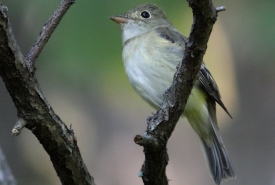
Acadian flycatcher (Photo by Bill Hubick)
Acadian flycatcher
What does the Acadian flycatcher look like?
A member of the flycatcher family, the Acadian flycatcher is a small songbird, measuring just 15 centimetres in length. They have a whitish to yellowish eye-ring, olive-green upperparts, pale underparts, dark-coloured wings with white wing bars and grey legs.
Acadian flycatchers are most easily identified by their peet-sa song.
Where does the Acadian flycatcher live?
Acadian flycatchers are long-distance migrants that breed in eastern North America. They migrate to Central America and northwestern South America during winter months. In Canada, Acadian flycatchers can only be found in the Carolinian forest region of southern Ontario. This region alone supports around 25 per cent of Canada’s species at risk.
Acadian flycatchers are area-sensitive. They have a preference for large, mature, closed-canopy deciduous forests. They prefer intact forests with relatively open understory. They build their nests suspended between small twigs, which often resemble clumps of fallen leaves.
What is the Acadian flycatcher's conservation status?
The Acadian flycatcher is assessed as endangered by the Committee on the Status of Endangered Wildlife in Canada. Widespread habitat loss threatens the species and has raised conservation concerns.
What is NCC doing to help protect the Acadian flycatcher's habitat?
The Nature Conservancy of Canada (NCC) is investing resources to conserve this unique species and its habitat in the Carolinian forest region. NCC is engaged in conservation and stewardship of high-quality existing habitat, such as Backus Woods. NCC conducts invasive species control and other stewardship work to maintain the ecological integrity of forest habitat.
Through large-scale restoration efforts, NCC is also working to increase the amount of habitat available to this species and others that depend on large areas of interior forest. Restoration involves the planting of native species in areas adjacent to existing forest. Over the long term, this will help the forest grow in size, and will serve as buffers against invasive species and other threats to Acadian flycatchers. These restored areas also connect existing natural areas to each other, helping to conserve and support the variety of species within this area.





